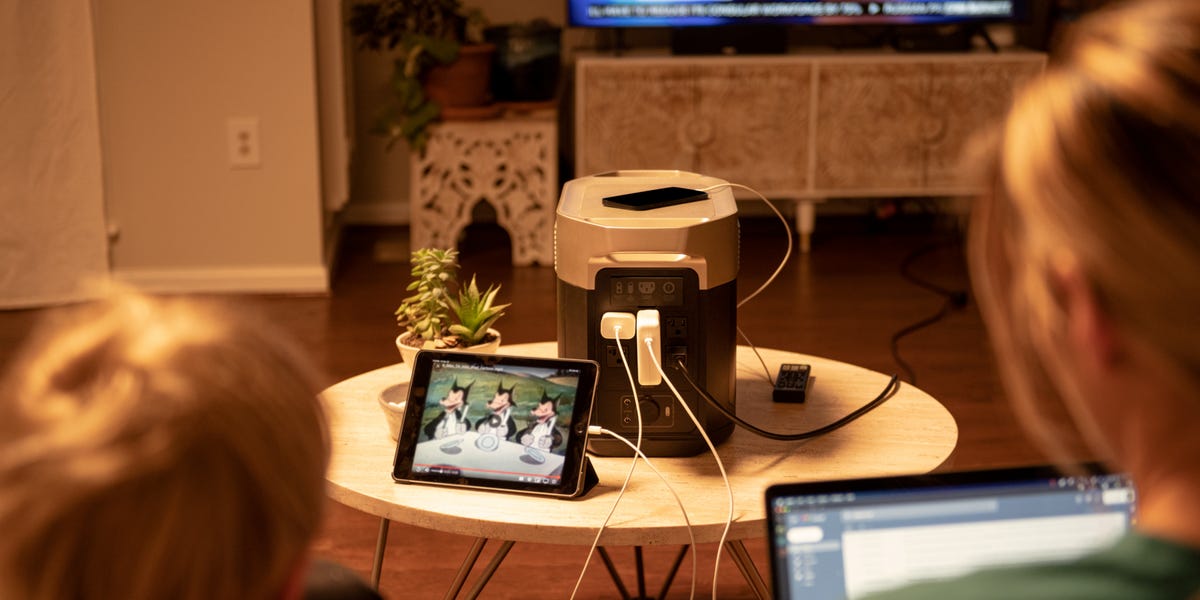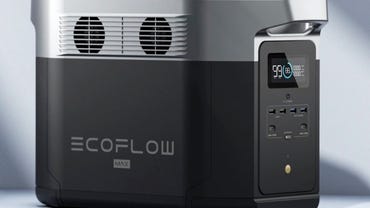Ecoflow Delta Max: Battery-powered generator can get you through most power outages

What if you could have an emergency generator that didn’t require gasoline, could be used inside the house without fear of asphyxiation, didn’t make a mess, and was far, far quieter than a traditional gasoline engine? If you live in an area prone to power outages, it could be a game changer.
The key is switching from gasoline technology to battery technology. Yes, there are a few disadvantages to battery technology (like you can’t just fill it back up), but in the main, battery generator technology opens the door to, literally, opening the door and bringing that generator inside your house.
As someone who’s lived through multiple week-long power outages in Florida, and a recent set of shorter outages due to wild fires in Oregon, I’m very interested in battery generators as an option.
While a whole-house integrated gasoline generator is probably the best choice, it’s also gobsmackingly expensive. To install such a thing, you need to have a team of contractors put in a concrete pad, merge the generator into the house’s electrical system, and install a very permanently-mounted generator. Back in Florida, I test-priced such a thing. When I found that the base cost of entry was well above $50,000, I decided it wasn’t something particularly practical.
But smaller portable gasoline generators are a pain to use. You have to set them up outside, where they become targets for thieves, especially after a long power outage turns neighbors into hostile competitors for scarce resources. You also have to have a way to safely store the gasoline — and this is an even bigger problem with permanently-mounted generators. Finally, you have to run a very long extension cord from outside to inside (usually through a cracked-open door or window), and then through much of your house. It’s just not fun.
Battery-based power station
When ZDNet’s long-time DIY-IT project partner Wellbots approached me to look at the Ecoflow Delta Max, I jumped at the opportunity. While I haven’t had a power outage in about a year, the possibility is always there.
I’ve used gasoline generators, but the Ecoflow (and all battery-based generators) require a bit of a mindset shift.
First, even though it’s a big battery you plug stuff into, it’s not a battery backup or surge suppressor. The difference is that it provides power like a generator, unlike a battery backup unit, which is designed to rapidly switch from wall power to battery power. Also, of course, the amount of battery even the biggest consumer UPSs put out is a tiny fraction of what something like the Ecoflow Delta Max is capable of.
Let’s talk about that power, and then I’ll circle back to how you should maintain and operate this thing.
Understanding power
The Ecoflow Delta Max is a 2016Wh power station. Wh is the abbreviation for watt hour. So, let’s back up a minute. A watt is a unit of power. Power, for those who slept through all those electrical engineering courses, is energy that is produced or consumed. Power is the flow of energy. If it were water, it would be water running in a river or through your pipes. It wouldn’t be water sitting in a glass or a tub.
So, a watt is a unit of power. We all know the term from incandescent bulbs. A 10W bulb is a lot less bright than a 100W bulb, and that’s because there’s one tenth of the power driving the light. By contrast, a watt hour is a unit of energy. Power is the flow of energy, but it’s the energy itself that does the work. That’s why your electric bill is often measured in kWh, or kilowatt hours. That’s the thousands of watt hours being put to work powering your home and place of work.
Another way of thinking about it is watt measures the flow, while watt hours measures how much flow you’ve used or can use in a given time. The 2016Wh means that the Ecoflow can handle roughly two kWh.
A more useful spec, however, is the wattage the device can produce. It can produce 2400W, which means it can power roughly 15 devices at once. A fridge uses somewhere between 100W and 250W, so even with a fridge on the circuit, quite a few devices can be powered.
Of course, since this is a battery, the more devices being used, the shorter the available power for those devices. The Ecoflow can interface with solar power, but I wasn’t sent any solar arrays for testing. Without solar to recharge, the Ecoflow has the charge that it has. Once depleted, you’re out of juice. It’s vaguely similar to being out of gas for your generator.
The Ecoflow does recharge rather rapidly. So if you did have a situation where the power was out, but came back on for a bit, before failing again, the Ecoflow could recharge. It takes less than two hours to recharge using wall power.
How long does it last?
That, of course, depends on what you want it to do. If you want it to provide supporting power out in a shed, on a boat, or on a camping trip, it will support most small appliances and tools. You probably could run a table saw on it for an hour or so, but that’s about it. By contrast, if you wanted it to keep your phone topped up, you could charge your phone probably a hundred times.
This also offers a particularly interesting work-at-home option. Many of us working at home have deadlines to meet and “show ups” to do, regardless of what our home situation is at the time. I’ve had to meet deadlines while driving through the desert during a hurricane evacuation.
This unit could definitely power your phone to act as a Wi-Fi hotspot, and then keep your laptop charged up so you can get the job done. Add the ability to brew coffee to keep your brain running, and you have a work-from-home continuity plan.
You might have some tradeoff decisions. It can keep a full size fridge cold for about 10 hours, a mini fridge cold for a little less than a day, but you might only get an hour or two from a window-shaker air conditioner.
For an extended outage, you might want to plug in the fridge for an hour, then unplug for an hour, which would extend the service for a longer time. You could use it to cook dinner with an air fryer, but choose something that cooks fast. An hour or so use will deplete the charge. If you use a coffee maker (which uses roughly a thousand watts), make just a few cups and unplug it. It will deplete a coffee maker churning out coffee constantly in about an hour or two (the scenario for this might be where the coffee maker is brought to an event or, say, a scouting weekend where lots of people are filling up).
According to the U.S. Energy Information Administration, power outages since 2013 averaged about two hours. However, starting in 2018, with increased wildfires and hurricanes, the average outage jumped to about 5.8 hours.
It’s in these situations where the Ecoflow shines. If you’re concerned about help making it through a typical outage, the Ecoflow could keep your food from spoiling, brew a cup or two of coffee, and recharge your phones. It probably couldn’t keep you cool all night, but it could help make it easier to get through the outage. I, personally, have a bunch of battery-powered fans, and these use so little current that they can make it through most of the night on a set of D-cells.
If, on the other hand, you live in hurricane country, where you’re likely to be without power for a week or more, the Ecoflow can’t help you on its own. You’ll need to invest in a set of solar panels. I haven’t done any testing of how fast these recharge and what the drain cycle would be. That’s something for a future article, if I ever get panels in to test.
The best case is if you can connect solar power to the unit to recharge. But even without solar power, this unit could help you get through a typical power outage.
Maintenance best practices
Maintaining a gas generator is different than maintaining a battery-based generator. You can’t just leave the Ecoflow out in the shed and add gas and plug things in when the power goes out. You have to keep it charged up so it’s available in case of power failure. And that requires a maintenance practice.
I reached out to the company for guidance and they told me that Ecoflow does NOT recommend keeping the unit plugged in, “as it may hurt the battery.” Instead, it requires a “charging-discharging maintenance every 3 months.” They recommend you discharge the device to 30%, and then recharge it to 85% every three months. I’m not sure why they want it charged to 85% and not 100%, but that’s their recommendation.
So, if you truly do want a power station that will get you through most power outages, you’ll need to add the discharge/charge maintenance cycle to your quarterly to-do list. That’s probably not too big a price to pay to have food-loss free power outages.
Bottom line
The Ecoflow Delta Max is not cheap. Wellbots sells it for a little over $2,000. For that price, you’re going to want the device to work for you when you need it. That means you’re going to need to do some proactive planning.
Decide what devices you want it to power during a power outage. Make sure you know where you’re going to deploy it, make sure you have the proper extension cords (best if stored with the unit). Perhaps even conduct a dry run or two to be sure your plans will work. And, of course, conduct the quarterly maintenance we discussed above.
Finally, there are a few things worth noting about this power station. The Ecoflow Delta Max isn’t the only power station in the Ecoflow line. Wellbots offers units ranging from about $350 and up, but of course the smaller units provide less power.
Also, I dug around on forums and reviews to get a feel for how customers liked the units and found an interesting set of mixed reviews. Overall, it seems that those who knew what they were getting were very happy with the device, while those who expected more of a magical power source were somewhat disappointed. One particular trend is something that’s easy to be aware of.
Apparently, the unit doesn’t provide its full power output right after a charge. Charging heats up the unit, so to manage heat, the unit throttles output until it’s cool enough to provide full power. Can you say “first law of thermodynamics“? Sure. I knew you could.
So, my bottom line is that this is what it is, and that’s a pretty cool thing. It’s a battery-based power station. If you understand how batteries and power work, and your expectations aren’t that of a mystical, never-ending power source, this is a solid solution. If you want it to offer more, you might want to invest in additional add-on batteries and solar panels.
What about you? Do you live somewhere where there are regular power outages? Do you have a plan for keeping going? Have you bought a generator? Do you like the idea of a battery-powered generator compared to a gasoline-powered one? Let us know in the comments below.
See also:
You can follow my day-to-day project updates on social media. Be sure to follow me on Twitter at @DavidGewirtz, on Facebook at Facebook.com/DavidGewirtz, on Instagram at Instagram.com/DavidGewirtz, and on YouTube at YouTube.com/DavidGewirtzTV.
READ MORE HERE

